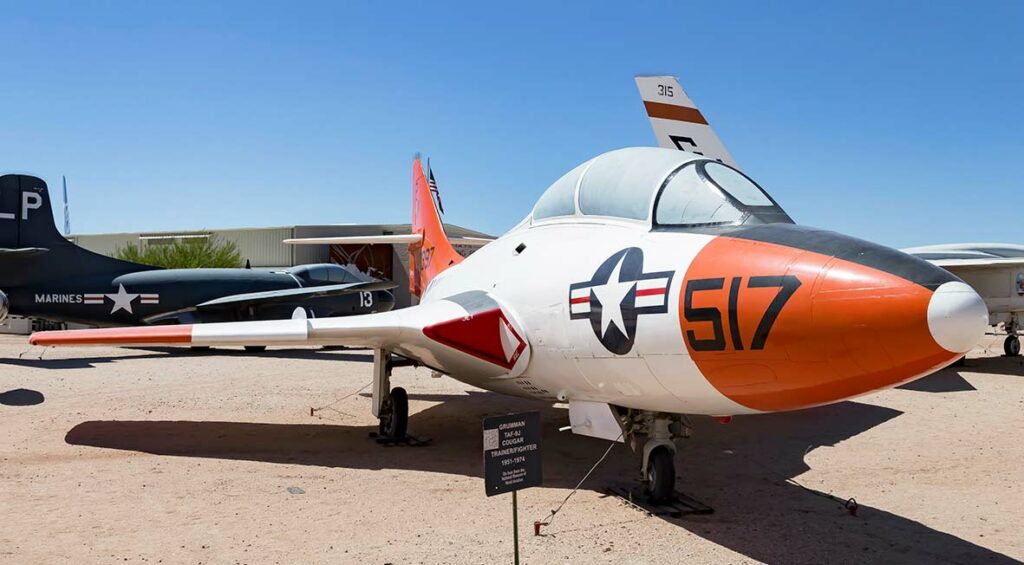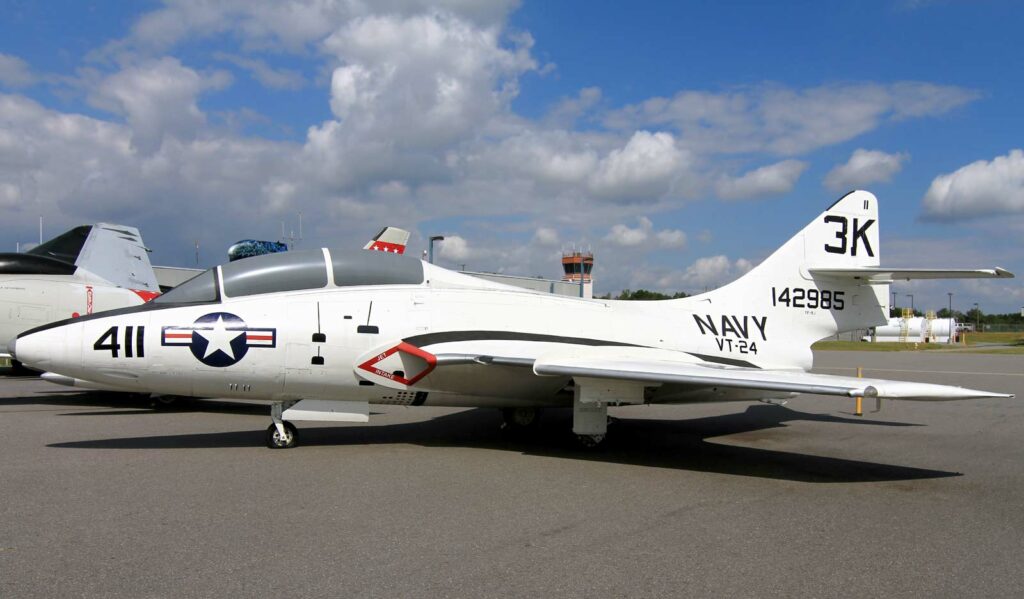The Grumman F9F Cougar was an American naval jet fighter and fighter-bomber, developed as an improved version of the Grumman F9F Panther.
In brief
The Grumman F9F Cougar was an American naval jet fighter and fighter-bomber, developed as an improved version of the Grumman F9F Panther. Introduced in the early 1950s, it featured a swept-wing design that significantly enhanced performance, particularly in speed and agility. The Cougar served primarily with the U.S. Navy and Marine Corps, participating in various Cold War conflicts including the Korean War. Known for its robustness and reliability, it was one of the U.S. Navy’s first jet fighters to be equipped with air-to-air missiles, marking it as a transitional aircraft between early jets and more advanced supersonic fighters.
In the rapidly evolving era of jet aviation following World War II, the Grumman F9F Cougar represented a significant advancement in naval aviation technology. Developed to address the limitations of straight-wing jets in a period dominated by the Korean War and Cold War tensions, the Cougar was a testament to the U.S. Navy’s commitment to maintaining cutting-edge aerial combat capabilities.

History of the Development of the Grumman F9F Cougar
Post-World War II aviation saw significant technological leaps, particularly in jet propulsion and aerodynamics. The U.S. Navy, recognizing the need for faster and more agile aircraft, initiated the development of the Grumman F9F Cougar in response to the experiences of naval aviators during the Korean War and the evolving Soviet threat.
Grumman, building on the success of the straight-wing F9F Panther, launched the Cougar program to incorporate swept wings, enhancing the aircraft’s speed and performance. The project aimed to provide a capable, carrier-based fighter that could secure air superiority and perform ground attack missions effectively. The Cougar first flew in 1951, demonstrating the potential of incorporating swept-wing technology into naval aircraft. While it did not receive a specific NATO nickname, its introduction marked a significant advancement in naval jet fighters, bridging the gap between early jets and the forthcoming supersonic era.
Design of the Grumman F9F Cougar
The Grumman F9F Cougar was a modification of the earlier Panther design, incorporating a 35-degree swept-wing to improve performance at high speeds. The aircraft measured approximately 42 feet in length and 34 feet in wingspan, with a high-tail design and tricycle landing gear typical of jet aircraft of the era.
The primary advantages of the Cougar included improved aerodynamic efficiency, higher speed, and better climb performance compared to its straight-wing predecessors. The swept-wing design, however, introduced new challenges, including increased takeoff and landing speeds, which necessitated more precise handling aboard carriers. Despite these drawbacks, the Cougar’s design represented a significant improvement in naval aviation capabilities, offering a balance of speed, maneuverability, and payload capacity.
Performance of the Grumman F9F Cougar
Powered by the Pratt & Whitney J48 turbojet, the Cougar was capable of speeds up to 647 mph (1,041 km/h) and had a service ceiling of around 42,000 feet (12,800 meters). Its operational range extended to approximately 1,000 miles (1,600 kilometers), making it effective for various mission profiles.
In comparison to its contemporaries, such as the North American F-86 Sabre and the Soviet MiG-15, the Cougar was competitive, particularly in its role as a carrier-based fighter. Its performance in the Korean War demonstrated its capabilities, though it was clear that the era of supersonic fighters was on the horizon, which would eventually surpass the Cougar and similar aircraft.
Variants of the Grumman F9F Cougar
The Cougar series included several variants, each designed to improve upon the initial model’s capabilities or fulfill specific operational roles. Key variants included the F9F-6, the initial production model; the F9F-7 with a different engine; and the F9F-8, featuring an extended wing and increased fuel capacity. There were also photo-reconnaissance versions and two-seat trainers, reflecting the versatility and adaptability of the design.

Military Use and Combat of the Grumman F9F Cougar
The Cougar saw significant service in the U.S. Navy and Marine Corps, particularly during the Korean War where it conducted fighter and ground attack missions. Its robustness and reliability made it a favorite among pilots, and it was one of the U.S. Navy’s primary jet fighters until more advanced models replaced it.
The aircraft’s armament typically included four 20 mm cannons and provisions for bombs and rockets, and later models could carry air-to-air missiles, reflecting the evolving nature of aerial combat. While the Cougar did not see extensive action beyond the Korean War, its service during this conflict and throughout the Cold War underscored its value as a capable, multi-role fighter.
The Grumman F9F Cougar stands as a pivotal aircraft in the transition from first-generation jet fighters to the more advanced designs that followed. Its introduction of swept-wing technology to carrier aviation marked a significant leap forward in performance and capabilities. Although eventually outpaced by newer, faster aircraft, the Cougar’s legacy is reflected in the subsequent generations of naval aircraft that built upon its advancements. As a symbol of early jet age innovation, the Cougar remains an important chapter in the history of military aviation.
Back to the Fighter Jet section.